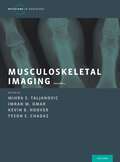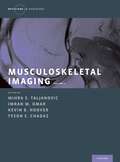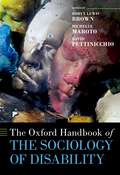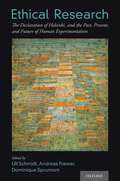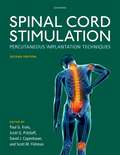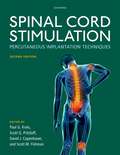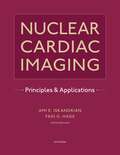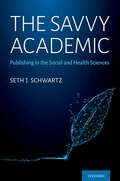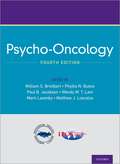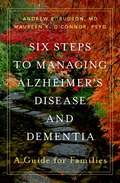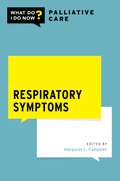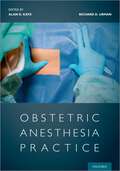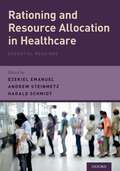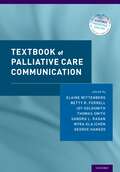- Table View
- List View
Musculoskeletal Imaging Volume 1: Trauma, Arthritis, and Tumor and Tumor-Like Conditions (Rotations in Radiology)
Musculoskeletal Imaging Volume 1 provides a comprehensive review of the subject matter commonly encountered by practicing radiologists and radiology residents in training. This volume includes succinct overviews of trauma, arthritis, and tumor and tumor-like conditions. Part of the Rotations in Radiology series, this book offers a guided approach to imaging diagnosis with examples of all imaging modalities complimented by the basics of interpretation and technique and the nuances necessary to arrive at the best diagnosis. Each pathology is covered with a targeted discussion that reviews the definition, clinical features, anatomy and physiology, imaging techniques, differential diagnosis, clinical issues, key points, and further reading. This organization is ideal for trainees' use during specific rotations, for exam review, or as a quick refresher for the established musculoskeletal imager. It is a must-read for residents and practicing radiologists seeking a foundation for the essential knowledge base in musculoskeletal imaging. Musculoskeletal Imaging Volume 2 reviews metabolic, infectious, and congenital diseases; internal derangement of joints; and arthography, and ultrasound.
Musculoskeletal Imaging Volume 1: Trauma, Arthritis, and Tumor and Tumor-Like Conditions (Rotations in Radiology)
by Mihra S. Taljanovic, Imran M. Omar, Kevin B. Hoover and Tyson S. ChadazMusculoskeletal Imaging Volume 1 provides a comprehensive review of the subject matter commonly encountered by practicing radiologists and radiology residents in training. This volume includes succinct overviews of trauma, arthritis, and tumor and tumor-like conditions. Part of the Rotations in Radiology series, this book offers a guided approach to imaging diagnosis with examples of all imaging modalities complimented by the basics of interpretation and technique and the nuances necessary to arrive at the best diagnosis. Each pathology is covered with a targeted discussion that reviews the definition, clinical features, anatomy and physiology, imaging techniques, differential diagnosis, clinical issues, key points, and further reading. This organization is ideal for trainees' use during specific rotations, for exam review, or as a quick refresher for the established musculoskeletal imager. It is a must-read for residents and practicing radiologists seeking a foundation for the essential knowledge base in musculoskeletal imaging. Musculoskeletal Imaging Volume 2 reviews metabolic, infectious, and congenital diseases; internal derangement of joints; and arthography, and ultrasound.
Musculoskeletal Imaging Volume 2: Metabolic, Infectious, and Congenital Diseases; Internal Derangement of the Joints; and Arthrography and Ultrasound (Rotations in Radiology)
Musculoskeletal Imaging Volume 2 provides a comprehensive review of the subject matter commonly encountered by practicing radiologists and radiology residents in training. This volume includes succinct overviews of metabolic, infectious, and congenital diseases; internal derangement of joints; and arthography, and ultrasound. Part of the Rotations in Radiology series, this book offers a guided approach to imaging diagnosis with examples of all imaging modalities complimented by the basics of interpretation and technique and the nuances necessary to arrive at the best diagnosis. Each pathology is covered with a targeted discussion that reviews the definition, clinical features, anatomy and physiology, imaging techniques, differential diagnosis, clinical issues, key points, and further reading. This organization is ideal for trainees' use during specific rotations, for exam review, or as a quick refresher for the established musculoskeletal imager. It is a must-read for residents and practicing radiologists seeking a foundation for the essential knowledge base in musculoskeletal imaging. Musculoskeletal Imaging Volume 1 reviews trauma, arthritis, and tumor and tumor-like conditions.
Musculoskeletal Imaging Volume 2: Metabolic, Infectious, and Congenital Diseases; Internal Derangement of the Joints; and Arthrography and Ultrasound (Rotations in Radiology)
by Mihra S. Taljanovic, Imran M. Omar, Kevin B. Hoover and Tyson S. ChadazMusculoskeletal Imaging Volume 2 provides a comprehensive review of the subject matter commonly encountered by practicing radiologists and radiology residents in training. This volume includes succinct overviews of metabolic, infectious, and congenital diseases; internal derangement of joints; and arthography, and ultrasound. Part of the Rotations in Radiology series, this book offers a guided approach to imaging diagnosis with examples of all imaging modalities complimented by the basics of interpretation and technique and the nuances necessary to arrive at the best diagnosis. Each pathology is covered with a targeted discussion that reviews the definition, clinical features, anatomy and physiology, imaging techniques, differential diagnosis, clinical issues, key points, and further reading. This organization is ideal for trainees' use during specific rotations, for exam review, or as a quick refresher for the established musculoskeletal imager. It is a must-read for residents and practicing radiologists seeking a foundation for the essential knowledge base in musculoskeletal imaging. Musculoskeletal Imaging Volume 1 reviews trauma, arthritis, and tumor and tumor-like conditions.
The Oxford Handbook of the Sociology of Disability (OXFORD HANDBOOKS SERIES)
The Oxford Handbook of the Sociology of Disability provides a timely and comprehensive overview of the wide range and depth of sociological theory and research on disability-brought together for the first time in one volume. Each section of the Handbook incorporates a uniquely sociological perspective, presented by a wide-range of experts on intersecting social, economic, political, and cultural dimensions of disability, that complements disability scholarship. The 37 chapters in this Handbook, organized into three major sections, provide an assessment of the history of the field, its current state, and the future for research on and in the sociology of disability. The first section reviews frameworks foundational to the study of disability, pushes for the inclusion of broader global perspectives, and addresses important dimensions of representation. The second section presents a combination of perspectives that tie together individual biography, societal contexts, and historic change, while emphasizing continuity and change in the dynamic processes linking individuals, institutions, and structures over time. In the third section, contributors investigate the reproduction of inequality through law, policy, and related institutions and systems, while highlighting how social and political participation empowers people with disabilities and helps to mitigate inequalities and social marginalization. The chapters included in this volume offer a multifaceted resource for students and experienced scientists alike on historical developments, main standards, key issues, and current challenges in the sociological study of disability at the global, national, and regional levels.
The Oxford Handbook of the Sociology of Disability (OXFORD HANDBOOKS SERIES)
by Robyn Lewis Brown, Michelle Maroto, David PettinicchioThe Oxford Handbook of the Sociology of Disability provides a timely and comprehensive overview of the wide range and depth of sociological theory and research on disability-brought together for the first time in one volume. Each section of the Handbook incorporates a uniquely sociological perspective, presented by a wide-range of experts on intersecting social, economic, political, and cultural dimensions of disability, that complements disability scholarship. The 37 chapters in this Handbook, organized into three major sections, provide an assessment of the history of the field, its current state, and the future for research on and in the sociology of disability. The first section reviews frameworks foundational to the study of disability, pushes for the inclusion of broader global perspectives, and addresses important dimensions of representation. The second section presents a combination of perspectives that tie together individual biography, societal contexts, and historic change, while emphasizing continuity and change in the dynamic processes linking individuals, institutions, and structures over time. In the third section, contributors investigate the reproduction of inequality through law, policy, and related institutions and systems, while highlighting how social and political participation empowers people with disabilities and helps to mitigate inequalities and social marginalization. The chapters included in this volume offer a multifaceted resource for students and experienced scientists alike on historical developments, main standards, key issues, and current challenges in the sociological study of disability at the global, national, and regional levels.
Ethical Research: The Declaration of Helsinki, and the Past, Present, and Future of Human Experimentation
by Ulf Schmidt, Andreas Frewer and Dominique SprumontAt the heart of research with human beings is the moral notion that the experimental subject is altruistic, and is primarily concerned for the welfare of others. Beneath the surface, however, lies a very different ethical picture. Individuals participating in potentially life-saving research sometimes take on considerable risks to their own well-being. Efforts to safeguard human participants in clinical trials have intensified ever since the first version of the World Medical Association's Declaration of Helsinki (1964) and are now codified in many national and international laws and regulations. However, a comprehensive understanding of how this cornerstone document originated, changed, and functions today does not yet exist in the sphere of human research. Ethical Research brings together the work of leading experts from the fields of bioethics, health and medical law, the medical humanities, biomedicine, the medical sciences, philosophy, and history. Together, they focus on the centrality of the Declaration of Helsinki to the protection of human subjects involved in experimentation in an increasingly complex industry and in the government-funded global research environment. The volume's historical and contemporary perspectives on human research address a series of fundamental questions: Is our current human protection regime adequately equipped to deal with new ethical challenges resulting from advances in high-tech biomedical science? How important has the Declaration been in non-Western regions, for example in Eastern Europe, Africa, China, and South America? Why has the bureaucratization of regulation led to calls to pay greater attention to professional responsibility? Ethical Research offers insight into the way in which philosophy, politics, economics, law, science, culture, and society have shaped, and continue to shape, the ideas and practices of human research.
Spinal Cord Stimulation: Percutaneous Implantation Techniques
Neuromodulation therapies such as spinal cord, dorsal root ganglion, and peripheral nerve stimulation are used to treat chronic pain syndromes such as intractable back pain, diabetic neuropathy, spinal radiculopathies, and complex regional pain syndrome. Since the publication of the first edition over a decade ago, there has been unprecedented progress in understanding neuromodulation and technological advances in clinical applications. Spinal Cord Stimulation is intended as an essential guide to the clinical fundamentals required for safe and effective implantation of neuromodulation devices. Implantation of these devices is performed by physicians from various disciplines, requiring a multidisciplinary skill set that presents a challenge for surgical and non-surgical pain practitioners alike. This authoritative resource integrates the basic multidisciplinary information necessary for understanding spinal cord stimulation, dorsal root ganglion (DRG), and peripheral nerve stimulation (PNS) with up-to-date implantation techniques for clinicians to use in their daily practice. It also features updated advice for appropriate medical decision making, patient education, safe use of radiation, and managing adverse events, with new chapters dedicated toward DRG stimulation and PNS.
Spinal Cord Stimulation: Percutaneous Implantation Techniques
by Paul G. Kreis, Scott G. Pritzlaff, David J. Copenhaver, and Scott M. FishmanNeuromodulation therapies such as spinal cord, dorsal root ganglion, and peripheral nerve stimulation are used to treat chronic pain syndromes such as intractable back pain, diabetic neuropathy, spinal radiculopathies, and complex regional pain syndrome. Since the publication of the first edition over a decade ago, there has been unprecedented progress in understanding neuromodulation and technological advances in clinical applications. Spinal Cord Stimulation is intended as an essential guide to the clinical fundamentals required for safe and effective implantation of neuromodulation devices. Implantation of these devices is performed by physicians from various disciplines, requiring a multidisciplinary skill set that presents a challenge for surgical and non-surgical pain practitioners alike. This authoritative resource integrates the basic multidisciplinary information necessary for understanding spinal cord stimulation, dorsal root ganglion (DRG), and peripheral nerve stimulation (PNS) with up-to-date implantation techniques for clinicians to use in their daily practice. It also features updated advice for appropriate medical decision making, patient education, safe use of radiation, and managing adverse events, with new chapters dedicated toward DRG stimulation and PNS.
Nuclear Cardiac Imaging: Principles and Applications
Nuclear cardiac imaging refers to cardiac radiological diagnostic techniques performed with the aid of radiopharmaceuticals, which are perfused into the myocardium as markers. These imaging studies provide a wide range of information about the heart, including the contractility of the heart, the amount of blood supply to the heart and whether parts of the heart muscle are alive or dead. This is essential information for cardiologists, and nuclear imaging has become an increasingly important part of the cardiologist's armamentarium. Chapters in Nuclear Cardiac Imaging cover historical, technical and physiological considerations, diagnosis and prognosis, conditions other than Coronary Artery Disease (CAD), advanced cardiac imaging, and challenges and opportunities. New to the sixth edition are key point summaries at the start of each chapter, clinical cases with videos, and a question and answer chapter on practical issues. This volume is ideal for nuclear cardiologists in training and nuclear clinicians alike who are searching for quick answers to important clinical and technical questions.
Nuclear Cardiac Imaging: Principles and Applications
by Ami E. Iskandrian and Fadi G. HageNuclear cardiac imaging refers to cardiac radiological diagnostic techniques performed with the aid of radiopharmaceuticals, which are perfused into the myocardium as markers. These imaging studies provide a wide range of information about the heart, including the contractility of the heart, the amount of blood supply to the heart and whether parts of the heart muscle are alive or dead. This is essential information for cardiologists, and nuclear imaging has become an increasingly important part of the cardiologist's armamentarium. Chapters in Nuclear Cardiac Imaging cover historical, technical and physiological considerations, diagnosis and prognosis, conditions other than Coronary Artery Disease (CAD), advanced cardiac imaging, and challenges and opportunities. New to the sixth edition are key point summaries at the start of each chapter, clinical cases with videos, and a question and answer chapter on practical issues. This volume is ideal for nuclear cardiologists in training and nuclear clinicians alike who are searching for quick answers to important clinical and technical questions.
The Savvy Academic: Publishing in the Social and Health Sciences
by Seth J. SchwartzThis approachable guide meets health and social sciences scholars at their level--either as a reference text or as an enchanting but practical read--and walks them through each stage of their academic publishing journey. Drawing on a wealth of examples from his own experience mentoring others and publishing 300+ articles, Dr. Schwartz engages early, mid-, and senior-level professionals as well as graduate students and postdoctoral fellows alike, to demystify each stage of the writing and publishing process. Employing a reader-friendly, accessible voice, Dr. Schwartz's style captivates readers across disciplines, with a refreshing, can-do perspective. Before diving in, the author relates his own personal story in scholarly publishing, inviting all academics to unlock the high-impact writer within. The next set of chapters tackle the nuts and bolts of the academic publishing process, with basics such as topic selection, data analysis for publication, writing preparation, drafting and editing manuscripts, and journals submissions. The book advances into more innovative topics that can be simultaneously intimidating and rewarding, including recruiting and collaborating with coauthors, developing a network, navigating the peer review process, publishing nonempirical papers, getting creative with rejected manuscripts, foraying into Open Access and fee-based publishing, and even how to publish a book or book chapter. Designed as a digital mentor, The Savvy Academic is the ultimate tool for students, fellows, and scholarly professionals of a broad range of experiences in the health and social sciences who are looking to launch or elevate their scholarly publication career.
The Savvy Academic: Publishing in the Social and Health Sciences
by Seth J. SchwartzThis approachable guide meets health and social sciences scholars at their level--either as a reference text or as an enchanting but practical read--and walks them through each stage of their academic publishing journey. Drawing on a wealth of examples from his own experience mentoring others and publishing 300+ articles, Dr. Schwartz engages early, mid-, and senior-level professionals as well as graduate students and postdoctoral fellows alike, to demystify each stage of the writing and publishing process. Employing a reader-friendly, accessible voice, Dr. Schwartz's style captivates readers across disciplines, with a refreshing, can-do perspective. Before diving in, the author relates his own personal story in scholarly publishing, inviting all academics to unlock the high-impact writer within. The next set of chapters tackle the nuts and bolts of the academic publishing process, with basics such as topic selection, data analysis for publication, writing preparation, drafting and editing manuscripts, and journals submissions. The book advances into more innovative topics that can be simultaneously intimidating and rewarding, including recruiting and collaborating with coauthors, developing a network, navigating the peer review process, publishing nonempirical papers, getting creative with rejected manuscripts, foraying into Open Access and fee-based publishing, and even how to publish a book or book chapter. Designed as a digital mentor, The Savvy Academic is the ultimate tool for students, fellows, and scholarly professionals of a broad range of experiences in the health and social sciences who are looking to launch or elevate their scholarly publication career.
Almost Over: Aging, Dying, Dead
by F. M. KammIn Almost Over, F. M. Kamm presents a wide-ranging philosophical discussion of the moral, legal, and medical issues related to aging, dying, and death. She begins by considering different views about whether and why death is bad for the person who dies and what these views imply about the death of humanity. She then considers whether there are conditions under which it might make sense to deliberately bring a person's death about, given the processes of aging and dying that precede it. In the opinion of some it is not only serious illness but ordinary aging that may give rise to this question and Kamm pays particular attention to the various ways in which aging could affect the distribution of "goods" and "bads" in a particular life. Specifically, she considers how the limitations and changes due to aging and the dying process affect meaning in one's life, and whether the absence of meaning affects the reasonableness of not resisting or even seeking one's death. Kamm explores these questions not only as they relate to individuals' decisions but also as they relate to public policy and state action. Recently attempts have been made to help the general public think about end-of-life issues by devising questionnaires and conversation guides; Kamm evaluates some of these resources and articulates the moral implications of the assumptions they make about aging, dying, and value. She also takes up the issue of physician-assisted suicide as a way of ending one's life, considering its moral permissibility and whether or not it ought to be legalized as a matter of public policy. In doing so, she examines arguments from discussions about capital punishment concerning state action and also methods of balancing costs and benefits (including cost effectiveness analysis). In her analysis, Kamm engages with the views of such prominent philosophers, medical doctors, and legal theorists as Shelly Kagan, Susan Wolf, Atul Gawande, Ezekiel Emanual, and Neil Gorsuch, among others, shedding new light on conversations about the moral complexities and consequences of aging, dying, and death.
Almost Over: Aging, Dying, Dead
by F. M. KammIn Almost Over, F. M. Kamm presents a wide-ranging philosophical discussion of the moral, legal, and medical issues related to aging, dying, and death. She begins by considering different views about whether and why death is bad for the person who dies and what these views imply about the death of humanity. She then considers whether there are conditions under which it might make sense to deliberately bring a person's death about, given the processes of aging and dying that precede it. In the opinion of some it is not only serious illness but ordinary aging that may give rise to this question and Kamm pays particular attention to the various ways in which aging could affect the distribution of "goods" and "bads" in a particular life. Specifically, she considers how the limitations and changes due to aging and the dying process affect meaning in one's life, and whether the absence of meaning affects the reasonableness of not resisting or even seeking one's death. Kamm explores these questions not only as they relate to individuals' decisions but also as they relate to public policy and state action. Recently attempts have been made to help the general public think about end-of-life issues by devising questionnaires and conversation guides; Kamm evaluates some of these resources and articulates the moral implications of the assumptions they make about aging, dying, and value. She also takes up the issue of physician-assisted suicide as a way of ending one's life, considering its moral permissibility and whether or not it ought to be legalized as a matter of public policy. In doing so, she examines arguments from discussions about capital punishment concerning state action and also methods of balancing costs and benefits (including cost effectiveness analysis). In her analysis, Kamm engages with the views of such prominent philosophers, medical doctors, and legal theorists as Shelly Kagan, Susan Wolf, Atul Gawande, Ezekiel Emanual, and Neil Gorsuch, among others, shedding new light on conversations about the moral complexities and consequences of aging, dying, and death.
Psycho-Oncology
Originally published in 1998, Psycho-Oncology was the first comprehensive text in the field and remains the gold standard today. Previously led by Dr. Jimmie C. Holland, the founder of the field, this new edition is edited by a team of internationally renowned experts in psycho-oncology. The text reflects the interdisciplinary nature and global reach of this growing field. It covers evidence-based clinical practice guidelines from around the world, survivorship issues, psychotherapeutic interventions, and psychopharmacologic interventions. Thoroughly updated and developed in collaboration with the American Psychosocial Oncology Society and the International Psycho-Oncology Society, the fourth edition is a current, comprehensive reference for psychiatrists, psychologists, oncologists, hospice workers, and social workers seeking to understand and manage the psychological issues involved in the care of persons with cancer and the psychological, social, and behavioral factors that contribute to cancer risk and survival.
Psycho-Oncology
by William S. Breitbart, Phyllis N. Butow, Paul B. Jacobsen, Wendy W. T. Lam, Mark Lazenby and Matthew J. LoscalzoOriginally published in 1998, Psycho-Oncology was the first comprehensive text in the field and remains the gold standard today. Previously led by Dr. Jimmie C. Holland, the founder of the field, this new edition is edited by a team of internationally renowned experts in psycho-oncology. The text reflects the interdisciplinary nature and global reach of this growing field. It covers evidence-based clinical practice guidelines from around the world, survivorship issues, psychotherapeutic interventions, and psychopharmacologic interventions. Thoroughly updated and developed in collaboration with the American Psychosocial Oncology Society and the International Psycho-Oncology Society, the fourth edition is a current, comprehensive reference for psychiatrists, psychologists, oncologists, hospice workers, and social workers seeking to understand and manage the psychological issues involved in the care of persons with cancer and the psychological, social, and behavioral factors that contribute to cancer risk and survival.
Six Steps to Managing Alzheimer's Disease and Dementia: A Guide for Families
by Andrew E. Budson Maureen K. O'ConnorYour needs as a caregiver are just as important as those your family member with Alzheimer's Disease or dementia. This book will provide just the insight and guidance you need. Caregiving for a loved one with Alzheimer's disease or dementia is hard. It's hard whether you're caring for your spouse, parent, grandparent, sibling, other family member, or friend. Even if you had an extra ten hours each day to do it, it's hard to manage all the problems that come with dementia. And caring for a loved one with dementia can sometimes feel like a long, lonely journey. Six Steps to Managing Alzheimer's Disease and Dementia can help, addressing concerns such as: · Is the problem Alzheimer's, dementia, or something else? · How do you approach problems in dementia? · How do you manage problems with memory, language, and vision? · How do you cope with emotional and behavioral problems? · What are the best ways to manage troubles with sleep and incontinence? · Which medications can help? · Which medications can actually make things worse? · How do you build your care team? · Why is it important to care for yourself? · How do you sustain your relationship with your loved one? · How do you plan for the progression of dementia? · How do you plan for the end and beyond? Six Steps to Managing Alzheimer's Disease and Dementia is comprehensive yet written in an easy-to-read style, featuring clinical vignettes and character-based stories that provide real-life examples of how to successfully manage Alzheimer's disease and dementia.
Six Steps to Managing Alzheimer's Disease and Dementia: A Guide for Families
by Andrew E. Budson Maureen K. O'ConnorYour needs as a caregiver are just as important as those your family member with Alzheimer's Disease or dementia. This book will provide just the insight and guidance you need. Caregiving for a loved one with Alzheimer's disease or dementia is hard. It's hard whether you're caring for your spouse, parent, grandparent, sibling, other family member, or friend. Even if you had an extra ten hours each day to do it, it's hard to manage all the problems that come with dementia. And caring for a loved one with dementia can sometimes feel like a long, lonely journey. Six Steps to Managing Alzheimer's Disease and Dementia can help, addressing concerns such as: · Is the problem Alzheimer's, dementia, or something else? · How do you approach problems in dementia? · How do you manage problems with memory, language, and vision? · How do you cope with emotional and behavioral problems? · What are the best ways to manage troubles with sleep and incontinence? · Which medications can help? · Which medications can actually make things worse? · How do you build your care team? · Why is it important to care for yourself? · How do you sustain your relationship with your loved one? · How do you plan for the progression of dementia? · How do you plan for the end and beyond? Six Steps to Managing Alzheimer's Disease and Dementia is comprehensive yet written in an easy-to-read style, featuring clinical vignettes and character-based stories that provide real-life examples of how to successfully manage Alzheimer's disease and dementia.
Respiratory Symptoms (WHAT DO I DO NOW PALLIATIVE CARE)
by Margaret L. CampbellWhat Do I Do Now: Respiratory Symptoms is the first book of its kind to succinctly describe the palliative care approach to patients experiencing respiratory symptoms throughout their illness trajectory. Dyspnea, also known as breathlessness, is one of the most difficult symptoms to experience and is also one of the most difficult to treat as the evidence-base for this symptom lags behind other prevalent symptoms, such as pain or nausea. This volume brings together expertise from the fields of nursing, chaplaincy, social work, and psychology to address dyspnea from a palliative care context. Covering patients ranging from pediatric to geriatric, each chapter opens with a case study and provides context for the practical clinical content that follows.
Respiratory Symptoms (WHAT DO I DO NOW PALLIATIVE CARE)
by Margaret L. CampbellWhat Do I Do Now: Respiratory Symptoms is the first book of its kind to succinctly describe the palliative care approach to patients experiencing respiratory symptoms throughout their illness trajectory. Dyspnea, also known as breathlessness, is one of the most difficult symptoms to experience and is also one of the most difficult to treat as the evidence-base for this symptom lags behind other prevalent symptoms, such as pain or nausea. This volume brings together expertise from the fields of nursing, chaplaincy, social work, and psychology to address dyspnea from a palliative care context. Covering patients ranging from pediatric to geriatric, each chapter opens with a case study and provides context for the practical clinical content that follows.
Obstetric Anesthesia Practice
As the practice of obstetric anesthesia becomes increasingly recognized as a major subspecialty of anesthesia, there is a growing interest from current practitioners to evolve their neuraxial, regional, and general anesthesia techniques and understanding of the latest evidence. Obstetric Anesthesia Practice is a timely update in the field, providing a concise, evidence-based, and richly illustrated book for students, trainees, and practicing clinicians. Comprehensive in scope, this book addresses the essential topics necessary for the practitioner to quickly assess the patient and risk stratify them, decide on the type of analgesic and anesthetic plan most appropriate as well as its feasibility and safety, provide expert consultation to the other members of the obstetric team, manage anesthesia care and complications, and arrange for advanced care if needed.
Obstetric Anesthesia Practice
by Alan D. Kaye, Richard D. UrmanAs the practice of obstetric anesthesia becomes increasingly recognized as a major subspecialty of anesthesia, there is a growing interest from current practitioners to evolve their neuraxial, regional, and general anesthesia techniques and understanding of the latest evidence. Obstetric Anesthesia Practice is a timely update in the field, providing a concise, evidence-based, and richly illustrated book for students, trainees, and practicing clinicians. Comprehensive in scope, this book addresses the essential topics necessary for the practitioner to quickly assess the patient and risk stratify them, decide on the type of analgesic and anesthetic plan most appropriate as well as its feasibility and safety, provide expert consultation to the other members of the obstetric team, manage anesthesia care and complications, and arrange for advanced care if needed.
Rationing and Resource Allocation in Healthcare: Essential Readings
Budgets of governments and private insurances are limited. Not all drugs and services that appear beneficial to patients or physicians can be covered. Is there a core set of benefits that everyone should be entitled to? If so, how should this set be determined? Are fair decisions just impossible, if we know from the outset than not all needs can be met? While early work in bioethics has focused on clinical issues and a narrow set of principles, in recent years there has been a marked shift towards addressing broader population-level issues, requiring consideration of more demanding theories in philosophy, political science, and economics. At the heart of bioethics' new orientation is the goal of clarity on a complex set of questions in rationing and resource allocation. Rationing and Resource Allocation in Healthcare: Essential Readings provides key excerpts from seminal and pertinent texts and case studies about these topics, contextualized by original introductions. The volume is divided into three broad sections: Conceptual Distinctions and Ethical Theory; Rationing; and Resource Allocation. Containing the most important and classic articles surrounding the theoretical and practical issues related to rationing and how to allocate scare medical resources, this collection aims to assist and inform those who wish to be a part of bioethics' 21st century shift including practitioners and policy-makers, and students and scholars in the health sciences, philosophy, law, and medical ethics.
Textbook of Palliative Care Communication
The Textbook of Palliative Care Communication is the authoritative text on communication in palliative care, providing a compilation of international and interdisciplinary perspectives. This volume was uniquely developed by an interdisciplinary editorial team to address an array of providers including physicians, nurses, social workers, and chaplains, and it unites clinicians with academic researchers interested in the study of communication. By featuring practical conversation and curriculum tools stemming from research, this text integrates scholarship and inquiry into translatable content that others can use to improve their practice, teach skills to others, and engage in patient-centered communication. The volume begins by defining communication, explicating debatable issues in research, and highlighting specific approaches to studying communication in a palliative care context. Chapters focus on health literacy and cultural communication, patient and family communication, barriers and approaches to discussing palliative care with specific patient populations, pain, life support, advance care planning, and quality of life topics such as sexuality, spirituality, hope, and grief. Team communication in various care settings is outlined, and current research and education for healthcare professionals are summarized. Unique to this volume are chapters on conducting communication research, both qualitatively and quantitatively, to promote further research in palliative care.
